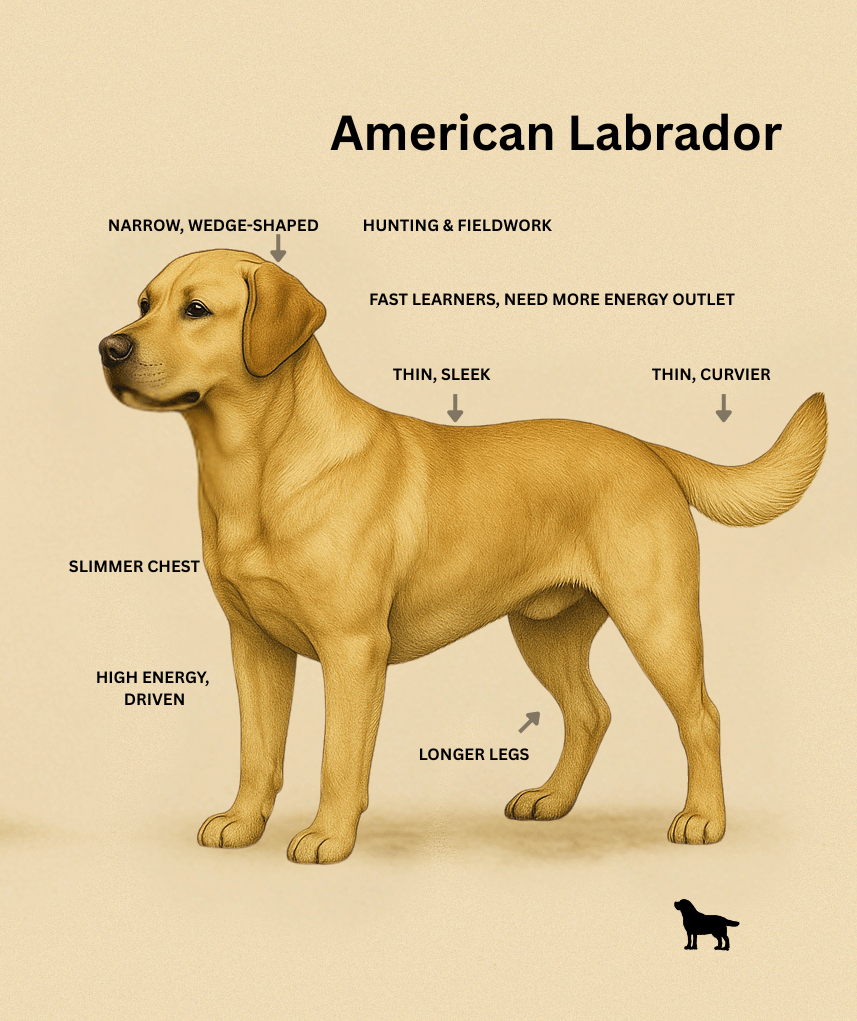English Labs vs American Labs: Key Differences, Traits & Which to Choose
English Labs vs American Labs

English Labs vs American Labs: Key Differences and Which to Choose
When it comes to choosing the perfect dog, the Labrador Retriever often tops the list. But did you know there are two distinct types? The differences extend beyond their origins. Each type offers unique traits, personalities, and physical characteristics that could make one a better fit for your home and lifestyle than the other. Whether you're looking for a hunting companion or a loyal family dog, understanding the nuances between the two is key.
Both English and American Labs are friendly, intelligent, and highly trainable. However, their history and breeding purposes have sculpted distinct versions of this beloved breed. Choosing between an English Lab and an American Lab is not just about looks; it’s about energy levels, trainability, and even how much hair you’re willing to sweep off your floors. Let’s dive into what makes these two Labs so special and so different.
History and Origin
The story of the Labrador Retriever breed starts not in England or America, but in Newfoundland, Canada. Originally known as the St. John’s Water Dog, these early retrievers were hardworking companions for fishermen, known for their ability to retrieve nets and haul in fish from the icy Atlantic waters. These John’s dogs, sturdy and full of natural ability, laid the foundation for today's Labradors.
In the 1800s, British nobles visiting Canada fell in love with these dogs' remarkable retrieving skills and brought them back to England. Here, selective breeding refined their characteristics. Over time, two distinct lines emerged: one bred for show ring standards leading to the English Lab and one bred for field trials and hunting, creating the American Lab. Thus, the history and origin of American and English Labs are deeply intertwined with their purpose, shaping the dogs we know and love today.
Recognition by Kennel Clubs
The Labrador Retriever's official journey began when the English Kennel Club recognized the breed in 1903, followed by the American Kennel Club in 1917. However, it didn't take long for the breed standard in each country to emphasize slightly different attributes.
The English Kennel Club emphasized a stockier, well-balanced dog, perfect for the show ring, with a focus on physical characteristics such as the otter tail, double coat, and a blocky head. Meanwhile, the American Kennel Club placed a strong emphasis on performance and agility, paving the way for American Labradors to become athletic hunting companions. These distinct standards over time have led to the physical and temperamental differences we see today between the two types.
Physical Characteristics
One of the most noticeable differences between English and American Labs is their appearance. English Labs tend to be stockier and more robust, with a broader head, shorter legs, and a more compact body. They usually weigh between 65 and 85 pounds, giving them a robust and solid look that's immediately recognizable. Their thick, dense coats and otter tails are perfect for cold-weather retrieving, a nod to their working dog heritage.
On the other hand, American Labs are built for speed and endurance. They have a leaner frame, longer legs, and a narrower head with a longer muzzle. Weighing between 55 and 70 pounds and standing between 21.5 and 24.5 inches, their athletic physique is ideal for hunting, dog agility, and long days spent outdoors. This sleeker body not only helps them move swiftly but also makes them stand out as competitors in field trials across the country.

Physical Traits and Appearance Comparison
If you were to line up two Labs, one English and one American, you'd notice even more physical differences. English Labradors are known for their thicker double coat, which gives them a plush, teddy-bear appearance. This thicker coat does mean they tend to shed more, but it's essential for keeping them warm during water activities. Their blocky heads and shorter, sturdier frames give them a more powerful appearance, almost as if they’re built for strength over speed.
In contrast, American Labs typically have a sleeker, thinner coat, and their body shape screams athleticism. Their longer legs and lighter bone structure make them incredibly agile, and their narrow heads give them a more streamlined appearance. Another notable difference is their tail: while both types have the signature otter tail, it tends to be more pronounced and thicker in English Labs. These physical traits don't just affect appearance; they influence each dog's performance in specific roles, such as hunting, retrieving, or simply lounging as a house pet.
Temperament and Personality
One of the most important aspects to consider when choosing between an English Lab and an American Lab is their temperament and personality. English Labs are typically calmer, more laid-back, and less excitable. They tend to mature earlier than their American cousins and exhibit a relaxed attitude, making them ideal family pets, therapy dogs, and wonderful companions for less active owners or those seeking a more low-key dog. Their strong desire to please, combined with their patient nature, makes them especially great around children and elderly individuals.
American Labs, however, are the Energizer Bunnies of the Labrador world. Bred for high-intensity activities such as field trials, upland hunting, and waterfowl hunting, they have a significantly higher energy level and require more exercise and mental stimulation. They are brilliant and often excel in retriever training and competitive sports, such as dog agility. However, without proper early socialization and consistent training methods, their boundless energy can sometimes translate into destructive behavior. If you lead an active lifestyle and want a working dog that's always up for an adventure, an American Lab might be the better fit.
High Energy Dogs
When discussing American Labs, it's impossible not to highlight their boundless energy. These dogs are true athletes, purpose-bred for field trials, competitive hunting, and even dog agility. Their athletic physique provides them with the stamina and endurance necessary for long days of retrieving game, running miles across fields, or swimming in lakes. American Labradors thrive on challenges and require vigorous exercise routines to stay healthy and happy.
That said, their high energy levels are not suited for every household. Without enough physical and mental stimulation, they can quickly become bored, leading to behaviors like digging, chewing, or excessive barking. Owners of American Labs must commit to daily activities like long walks, runs, or intensive play sessions. This is where their strong desire to work and please their humans shines. They're brilliant in structured settings, making them stars in retriever training, obedience trials, and even search-and-rescue missions. If you’re looking for a dog to join you on hikes, hunts, and adventures, American Labs typically won't disappoint.
Training and Intelligence
Both English and American Labs rank high on the intelligence scale among retriever breeds, but there are slight differences when it comes to training methods and learning styles. English Labradors are often easier for beginners to train because they are generally more relaxed, focused, and eager to please. Their natural calmness makes obedience training a smoother process, and they excel in roles such as therapy dogs, eye dogs, and emotional support animals.
On the other hand, American Labrador Retrievers are just as intelligent, if not more so, but their high energy and independence can pose challenges, particularly for novice trainers. These dogs need a firm but positive training style that channels their energy and enthusiasm in the right direction. They're outstanding in retriever training programs but require patience and consistency. Early socialization and structured training methods are essential for helping American Labs control their instincts and develop into well-mannered pets or working companions.
Hunting Dog Comparison
If you're choosing between the two based on hunting abilities, the comparison favors American Labs. Purpose-bred for field trials and competitive retrieval, American Labradors have the stamina, speed, and sharp focus needed for hunting in a variety of terrains. They're masters at upland hunting, waterfowl hunting, and other forms of active retrieving work. Their lighter frame and athletic physique make them quick, agile, and relentless in the field.
That’s not to say English Labs aren’t excellent hunting companions, too. Many hunters prefer the English counterpart for more relaxed and strategic hunts, where a slower, steadier approach is required. English Labs excel in scenarios that require patience, calm retrieval, and obedience. If you're into hunting but don't want a dog that’s bouncing off the walls 24/7, an English Labrador Retriever can be the perfect match. Their natural ability to retrieve, combined with their calm demeanor, makes them standout working dogs in their own right.

English Labrador Retriever and Family Life
When it comes to being the ultimate family dog, English Labradors tend to steal the spotlight. Their gentle, even-tempered nature makes them an outstanding choice for pets for families with children, elderly family members, or other dogs. They love human interaction, are patient with children, and have a natural ability to form deep bonds with their people. Their relatively lower energy level compared to their American counterparts means they’re content spending afternoons lounging with the family, making them the perfect house dog.
Moreover, English Labs adapt well to family life because they are less prone to hyperactivity. They are still playful and love a good game of fetch, but they won’t demand non-stop action. Early socialization ensures they grow up to be friendly, confident dogs who are comfortable in various social situations. Their loyalty, gentleness, and calmness make them excellent candidates for roles such as therapy dogs, emotional support animals, or even just your child's best friend. In the world of family pets, English Labs are genuinely among the best dogs you can bring home.
Labrador Retriever and Active Families
If you're an outdoor enthusiast or part of an active family, an American Lab might just be your dream dog. Known for being high energy dogs, American Labradors require and thrive on consistent exercise, challenges, and mental stimulation. They are happiest when they have a job to do, whether it’s participating in field trials, engaging in competitive dog agility, or accompanying you on a morning jog or weekend hiking adventure.
Families that love to spend time outside will find a fantastic companion in an American Lab. Their zest for life and ability to keep up with even the most active owners are unmatched. However, this energy also demands a serious commitment. Without sufficient outlets for their energy, American Labs can develop behavioral issues such as excessive chewing, barking, and hyperactivity. Structured playtime, obedience classes, and activities like retriever training are essential to keep these dynamic dogs well-balanced. If you're ready for a partner who's as eager to explore as you are, American Labs typically fit the bill perfectly.
Health and Wellbeing
Whether you choose an English Lab or an American Lab, health is a significant consideration. The Labrador Retriever breed is generally recognized for its robustness and longevity; however, both types are prone to similar health issues, including hip dysplasia, elbow dysplasia, and eye problems such as progressive retinal atrophy (PRA). Regular vet check-ups, maintaining a healthy diet, and ensuring your Lab gets adequate exercise are vital steps to safeguarding their wellbeing.
English Labs, with their heavier build, can be more prone to obesity if their diet isn't carefully monitored. Obesity can lead to joint issues and a decrease in overall quality of life. Meanwhile, American Labs, being more active, may be slightly more prone to sprains and injuries, especially if they are not properly conditioned for the vigorous activities they enjoy. Regardless of type, your Lab's health thrives on preventative care, an active lifestyle, and lots of love. Being proactive ensures your hunting companions or family pets remain by your side for many joyful years.
Grooming Needs and Maintenance
Grooming is another area where there are slight differences between the two types. Both English and American Labradors have a short, dense double coat that sheds throughout the year, with heavier shedding occurring during the spring and fall. However, English Labs, with their thicker, plusher coats, tend to shed more heavily, requiring more frequent brushing at least twice a week to manage loose fur and keep their coats shiny and healthy.
Meanwhile, American Labs, with their slightly thinner coats, are a little easier to manage in terms of daily grooming but may require more attention to their paws, nails, and ears. Being the more adventurous and outdoorsy type, American Labs are often exposed to dirt, debris, and potential ear infections from swimming or field activities. Regular ear cleaning, nail trimming, and brushing are essential for maintaining their health and hygiene. Grooming isn’t just about keeping them clean; it’s a bonding experience and an opportunity to check for any lumps, bumps, or hidden injuries.
Choosing the Best Lab for You
So, how do you decide between an English Lab and an American Lab? The choice ultimately depends on your lifestyle, your experience with dogs, and what you hope to gain from your furry friend. If you want a calm, loving house dog or a family dog that’s content with moderate exercise and lots of cuddles, the English Labrador Retriever is the way to go. They are fantastic with children, other pets, and adapt well to a less active household.
On the other hand, if you’re looking for a working lab one that can accompany you on hunts, hikes, and intense play sessions, the American Labrador Retriever is likely a better fit. Their athletic physique, stamina, and strong work ethic make them outstanding partners for active and adventurous owners. Remember, both types require early socialization, basic obedience training, and plenty of love and attention to reach their full potential as exceptional dogs. Whichever you choose, you’re guaranteed a loyal, intelligent, and affectionate companion.
When it comes to English Labs vs American Labs, there’s no one-size-fits-all answer. Both types offer unique characteristics that can make them the best dog for the right owner. English Labs bring calmness, loyalty, and a family-friendly temperament, making them perfect for quieter homes. American Labs, with their energy, intelligence, and drive, are ideal for active families and hunters who seek a lifelong companion for life’s adventures.
Understanding the physical differences, temperament, grooming needs, and energy levels of each type helps ensure that you choose a dog that fits seamlessly into your lifestyle. Whether you're looking for a family pet, a hunting dog, or a loyal friend, both English and American Labs are excellent choices. With proper care, training, and lots of affection, your Labrador, whether American or English, will be a cherished member of your family for years to come.

FAQ
How do I choose between an English and an American Lab?
Choosing between an English Lab and an American Lab comes down to evaluating your lifestyle, energy levels, and personal preferences. If you're someone who enjoys a slower pace, loves spending cozy evenings at home, or needs a reliable, laid-back companion, then an English Lab is likely the perfect fit. Their calm demeanor, lower exercise demands, and affectionate nature make them ideal for families, first-time dog owners, and even seniors.
On the other hand, if you lead a highly active lifestyle, such as hiking, running, hunting, or spending weekends outdoors, then the American Lab will likely suit you better. These dogs are bred for endurance, agility, and intelligence. They thrive when given a task and will happily keep up with even the busiest of owners. In short, if you want a dog that’s happy lounging with you on the couch, choose an English Lab. If you want a four-legged fitness buddy, the American Lab is the better match.
Before making a decision, also consider your time availability for training and exercising the dog. American Labs need more mental and physical stimulation, while English Labs are content with moderate activity and more downtime.
Are English Labs better for families?
English Labs are often regarded as one of the best family dogs available. They are known for their incredibly sweet, patient, and tolerant nature, making them excellent companions for families with young children or even other pets. English Labradors are naturally gentle and less rambunctious than their American counterparts, which means they are less likely to accidentally knock over small children or become too overwhelming in the home.
Their calm personality also facilitates easier training for families. Basic commands like "sit," "stay," and "come" are often mastered quickly with positive reinforcement. Plus, English Labs are very affectionate. They thrive on human interaction and are happiest when they are included in family activities, whether it's a backyard BBQ, a movie night, or a weekend at the park.
In addition to being great playmates for kids, English Labs also possess a nurturing, empathetic side that makes them wonderful emotional support animals. If you’re looking for a dog that seamlessly becomes a true member of the family, you really can't go wrong with an English Lab.
Can American Labs be calm house dogs?
While American Labs are naturally bursting with energy, with proper training, routine, and an outlet for their enthusiasm, they can become calm and well-behaved house dogs. It's essential to remember that American Labrador Retrievers were bred for field trials and working roles, which means they possess a strong internal drive to be active, challenged, and engaged.
To help an American Lab adapt to a calmer home life, you’ll need to provide plenty of daily physical exercise, at least one to two hours, and mental stimulation, such as puzzle toys, obedience training, or games like hide-and-seek. Long walks, runs, swimming, or structured play sessions are critical for burning off their excess energy.
Early training is crucial. Teaching commands like “settle,” “place,” and “quiet time” will help them understand when it’s time to switch gears from energetic play to relaxation. A well-exercised American Lab is a happy one, and a happy American Lab can indeed become a peaceful, loving companion who enjoys downtime just as much as adventure time.
What is the lifespan of English and American Labs?
Both English Labs and American Labs share a similar lifespan, typically living between 10 to 14 years with good care. Genetics, diet, lifestyle, and access to veterinary care all play critical roles in determining a Lab’s overall lifespan and quality of life.
Proper nutrition is a huge factor. Feeding your Lab a balanced, high-quality diet specifically designed for large breeds can help prevent many common health issues. Routine vet check-ups are essential for early detection of health problems, such as hip dysplasia, heart disease, or eye disorders, which are slightly more common in the Labrador Retriever breed.
Exercise is another key contributor to longevity. Both types of labs require regular physical activity to maintain a healthy weight and support joint health. Mental stimulation also matters; boredom and lack of engagement can lead to behavioral problems that might indirectly affect a dog’s health. With love, care, and proper management, your English or American Lab can live a whole, happy life well into their golden years.
How Much Exercise Do American Labs vs English Labs Need?
When it comes to exercise, American Labs and English Labs have very different needs, primarily due to their distinct breeding origins and natural energy levels.
American Labs are high-energy athletes at their core. They require a minimum of 1 to 2 hours of vigorous exercise every day to stay physically fit and mentally balanced. These dogs are not content with just a quick walk around the block. They thrive on activities that challenge both their bodies and their sharp minds.
Some ideal exercise activities for American Labs include:
- Long walks or adventurous hikes through parks, trails, or forests
- Running sessions or even short-distance jogging
- Swimming, which they love thanks to their thick double coats and natural affinity for water
- Fetch games or focused retriever training exercises
- Dog agility courses or structured playgroups with other energetic dogs
Without this level of stimulation, American Labs can quickly develop unwanted behaviors, such as chewing furniture, digging holes, or excessive barking. For them, exercise isn't just about burning off energy; it's crucial for maintaining good mental health and preventing destructive boredom.
On the other hand, English Labs have a more laid-back personality and require moderate daily exercise, typically around 45 minutes to 1 hour. While they still enjoy walks, playtime, and the occasional swim, they don’t have the same relentless drive for activity as their American cousins. English Labs are content with a brisk walk, a few games of fetch, and some quality time with the family. They’re naturally calmer and more suited for families who want a house dog that doesn’t demand constant adventure.

